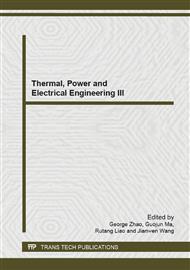p.52
p.57
p.61
p.65
p.69
p.73
p.78
p.82
p.87
Electron Beam Irradiation on Substrate for Precise Dielectrophoretic Assembly of Carbon Nanotubes - A Simulation
Abstract:
The effect of electron beam irradiation on permittivity of silicon dioxide insulate layer was investigated. Theoretical analysis indicates that electron beam irradiation will change the permittivity of SiO2 through decreasing the molecular number per unit volume and increasing the polarizability of the sample. The escape of impurities during irradiation decreases the permittivity while the accumulation of space charge increases the permittivity. Simulation results show that with the change of permittivity, the electric field of the area irradiated by electron beam is strengthened locally and carbon nanotubes (CNTs) are more likely attracted to this area by dielectrophoresis. Therefore, the method could be used for precise positioning of CNTs for various applications in many areas including nanoelectronics, sensors, and new energies.
Info:
Periodical:
Pages:
69-72
Citation:
Online since:
June 2014
Price:
Сopyright:
© 2014 Trans Tech Publications Ltd. All Rights Reserved
Share:
Citation:


